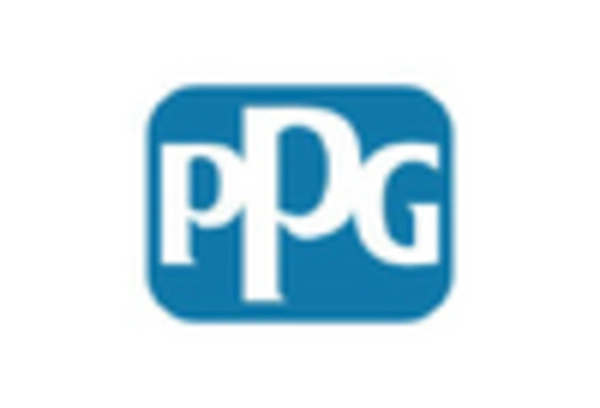Expansion of End-User Industries
The expansion of end-user industries such as healthcare, automotive, and consumer goods is driving the growth of the Anti-Viral Coating Market. As these sectors continue to evolve, the demand for protective coatings that can enhance safety and hygiene is becoming increasingly pronounced. For instance, the automotive industry is exploring anti-viral coatings for vehicle interiors to ensure passenger safety. Similarly, the healthcare sector is integrating these coatings into medical devices and hospital environments. This diversification of applications is expected to create new opportunities for manufacturers, thereby contributing to the overall growth of the market in the foreseeable future.
Rising Demand for Hygiene Solutions
The increasing emphasis on hygiene and cleanliness in various sectors appears to be a primary driver for the Anti-Viral Coating Market. As consumers and businesses alike prioritize health and safety, the demand for effective anti-viral solutions is likely to surge. This trend is particularly evident in healthcare, hospitality, and public transportation sectors, where surfaces are frequently touched. According to recent estimates, the anti-viral coating market is projected to grow at a compound annual growth rate of approximately 10% over the next five years. This growth is indicative of a broader shift towards preventive measures against viral infections, thereby enhancing the market's potential.
Growing Awareness of Infection Control
The rising awareness regarding infection control measures is a significant driver for the Anti-Viral Coating Market. Educational campaigns and public health initiatives are fostering a greater understanding of the importance of surface hygiene in preventing the spread of viruses. This heightened awareness is prompting businesses and consumers to seek out effective anti-viral solutions for their environments. As a result, the market is witnessing an influx of products designed to meet these needs, with a projected increase in market size anticipated in the coming years. The focus on infection control is likely to remain a key factor influencing purchasing decisions across various sectors.
Technological Innovations in Coating Materials
Technological advancements in coating materials are significantly influencing the Anti-Viral Coating Market. Innovations such as the development of nano-coatings and advanced polymer formulations are enhancing the efficacy and durability of anti-viral coatings. These innovations not only improve the performance of coatings but also expand their application range across various surfaces, including textiles, metals, and plastics. The introduction of self-cleaning and long-lasting coatings is expected to attract a wider customer base, thereby driving market growth. As manufacturers continue to invest in research and development, the market is likely to witness a surge in novel products that meet the evolving needs of consumers.
Increased Regulatory Support for Health Standards
Regulatory bodies are increasingly implementing stringent health and safety standards, which is likely to bolster the Anti-Viral Coating Market. Compliance with these regulations often necessitates the use of advanced materials that can effectively mitigate viral transmission. For instance, in sectors such as healthcare and food services, adherence to hygiene standards is paramount, leading to a heightened demand for anti-viral coatings. This regulatory push not only encourages manufacturers to innovate but also assures consumers of the safety and effectiveness of these products. As regulations evolve, the market is expected to expand, driven by the need for compliance and enhanced public health.


















Leave a Comment